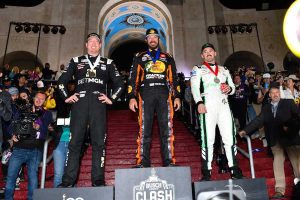INDIANAPOLIS – With each passing day it seems another race track closes or is in peril of doing so.
The reasons are varied. In some cases what was once a rural setting is now smack in the middle of suburban growth. This can lead to angry neighbors or skyrocketing land values, rendering the property too valuable to hold on to. There are also times when owners are just worn out and decide there is more to life than spending every weekend at the track and devoting every Monday to fielding calls from angry patrons.
It is difficult to make a living in this game. We can all look at old photos and films of fairground race tracks, big and small, packed to capacity. That ship has sailed. Given the general tendency to focus on the negative, many believe somebody or something must be blamed for the current state of affairs. One of the easy targets today is live-streaming broadcasts.
Is there a debate to be had here? Sure. Do I believe it is at the root of the seeming malaise that has gripped some segments of our sport? Absolutely not.
The armchair analysis for what ails racing often falls into two basic categories. The first is commonly expressed in this sentence: “There are no real promoters anymore.”

The theory goes that these folks have all become lazy and are relying on the back gate to make a buck. Because of that, shows are too long, kids are asleep before the night is over and fans are driven away.
There is an element of truth here. As I have noted many times in this column, fans of the so-called premier class, i.e., sprint cars or late models, might look around and realize that the “lower divisions” have supporters, too. I can tell you that at places like Bloomington, Paragon or Lincoln Park Speedway in Indiana there is interest in watching your co-worker or neighbor compete.
In almost all cases (and this is really a fairly recent trend), the schedule calls for the sprint cars or late models to run their features first. If you are going to survive as a weekly program, and many tracks have moved to a special-events only model, there must be a healthy back gate.
The other issue is marketing. Here the refrain suggests: If only tracks would really try to market their product all would be rosy. I remember when we held a press conference at Indianapolis Motor Speedway to highlight the innovative marketing campaign driven by a relationship with IZOD. It was supposed to be an absolute game-changer. I do not have the numbers. Perhaps this moved the needle a little. The problem here is how does one effectively market in today’s fragmented media world?
The inspiration for this missive was the reaction, at least in some quarters, to NASCAR’s recent Busch Light Clash at the L.A. Memorial Coliseum. Let us turn back the clock. I remember a conversation with the late Dave Cassidy about the so-called glory days of Indianapolis Motor Speedway.
Some readers may recall Dave as the general manager of the second-generation 16th Street Speedway, but he was also a great friend of the Hulman family and served as an assistant to IMS savior Tony Hulman. Once when reflecting on the explosion of interest in the Indianapolis 500 in the post-World War II era, he simply said, “We got lucky.” Elaborating, he recalled they were the beneficiary of the times, the place and the circumstances.
To that end, remember when NASCAR seemed to be the home of marketing geniuses? During that period if the doors opened, the fans came. There was even a book titled “The NASCAR Way: The Business that Drives the Sport.” It seemed like there were 19 NASCAR shows on television and radio. Then, the bubble appeared to burst and everyone had a theory as to why it happened. Overnight it seemed some race tracks closed and others quietly began dismantling grandstands. In today’s world, things change in a flash, including consumer’s tastes.
Suddenly, the NASCAR brass and individual track operators were experiencing the same challenges their short-track brethren had faced for years. What to do? The Clash in L.A. is a perfect example of searching for a hook to get people interested in the product. This is particularly true with what we might call casual fans.
Some of the reactions to this effort have been predictable, if at times comical. Did I enjoy the race at the Coliseum? Not really. Did I think it likely that this venue could provide compelling racing? No. Did I like all the other entertainment? I frankly did not give it much attention. Yet, for the record, I hate the halftime at the Super Bowl because I want to get back to the game. However, do I understand the rationale in play here? Absolutely.
The L. A. Memorial Coliseum is an iconic venue that has hosted a plethora of memorable sporting events. It is a unique backdrop in an important market. The attempt was made to build on that. That makes sense. The idea of presenting Olympic-type medals to the top three was a clever notion given the history here. When that was announced traditionalists howled.
It was here that the get-off-my-lawn crowd chipped in with the notion that NASCAR had fallen into the participation trophy rabbit hole. Give me a break. Third place in any major racing event is beyond just participating. Plus, if I was one of the recipients, I might think it was cool.
More to the point, this represented an effort to try something. There are several themes I have returned to in the years I have been a columnist. One of them is that our sport cannot survive on hardcore fans alone. There are not enough of them, and in some places, sadly, they are dying out.
In the classic book on leadership “In Search of Excellence,” Peters and Waterman tell the story of how one of the major petroleum companies had been more successful in finding oil than its peers. Did they have better geologists, researchers or technology? No. They drilled more holes.
One might think on this promotion NASCAR took a swing and missed. So be it. Nonetheless, racing cannot survive by standing still. What holds true for the so-called major leagues of the sport is also a guiding principle for the smallest local race track in the country.
Be wacky, be goofy, offer the fans something different. Some promotions will fail miserably. Others will be home runs.
This story appeared in the Feb. 22, 2023 edition of the SPEED SPORT Insider.

